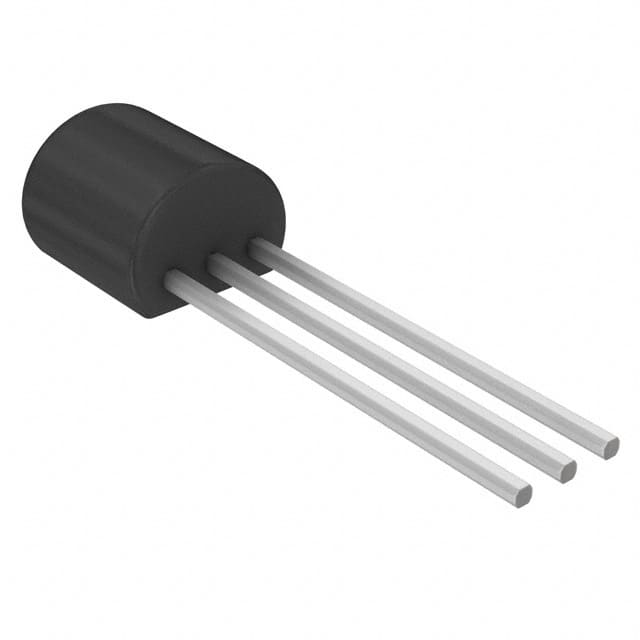Voir les spécifications pour les détails du produit.

2N3904 Transistor
Product Overview
The 2N3904 is a widely used NPN bipolar junction transistor (BJT) that falls under the category of small signal transistors. It is commonly utilized for amplification and switching purposes in various electronic circuits. The 2N3904 is known for its low cost, high reliability, and versatility. It is typically available in a TO-92 package and is sold in quantities suitable for both hobbyist and professional applications.
Specifications
- Maximum Collector-Emitter Voltage: 40V
- Maximum Collector-Base Voltage: 60V
- Maximum Emitter-Base Voltage: 6V
- Continuous Collector Current: 200mA
- Power Dissipation: 625mW
- Transition Frequency: 300MHz
- Operating Temperature Range: -55°C to 150°C
Detailed Pin Configuration
The 2N3904 transistor consists of three pins: 1. Emitter (E): This pin is typically connected to the ground or the common reference point in a circuit. 2. Base (B): The input signal is applied to this pin, controlling the transistor's operation. 3. Collector (C): The output signal is obtained from this pin.
Functional Features
The 2N3904 transistor offers high current gain, low noise, and low power consumption, making it suitable for various amplification and switching applications. Its compact size and ease of use contribute to its widespread popularity.
Advantages and Disadvantages
Advantages
- Low cost
- High reliability
- Versatile usage
- Compact package size
Disadvantages
- Limited power handling capability
- Moderate operating frequency range
Working Principles
In an amplification application, a small input current at the base terminal controls a larger current flow between the collector and emitter terminals. In a switching application, the transistor can be turned on and off by applying a small control signal to the base terminal, allowing or blocking the flow of current between the collector and emitter.
Detailed Application Field Plans
The 2N3904 transistor finds extensive use in audio amplifiers, signal processing circuits, voltage regulators, and logic level shifting circuits. It is also employed in oscillator circuits, LED drivers, and sensor interfaces due to its reliable performance and low cost.
Detailed and Complete Alternative Models
Some alternative models to the 2N3904 include the BC547, 2N2222, and PN2222A transistors. These alternatives offer similar characteristics and can be used interchangeably in many circuits where the 2N3904 is specified.
In conclusion, the 2N3904 transistor is a versatile and cost-effective component widely used in electronic circuits for amplification and switching purposes. Its compact size, reliability, and ease of use make it a popular choice among hobbyists and professionals alike.
[Word count: 398]
Énumérez 10 questions et réponses courantes liées à l'application de 2N3904 dans les solutions techniques
Sure, here are 10 common questions and answers related to the application of 2N3904 in technical solutions:
What is a 2N3904 transistor?
- The 2N3904 is an NPN bipolar junction transistor commonly used for amplification and switching purposes in electronic circuits.
What are the typical applications of a 2N3904 transistor?
- The 2N3904 transistor is commonly used in audio amplifiers, signal amplification, switching circuits, and as a general-purpose amplifier in various electronic devices.
What are the key electrical characteristics of the 2N3904 transistor?
- The 2N3904 has a maximum collector current of 200mA, a maximum collector-base voltage of 40V, and a maximum power dissipation of 625mW.
How do I identify the pinout of a 2N3904 transistor?
- The pinout of a 2N3904 transistor is typically Emitter (E), Base (B), and Collector (C). When viewing the flat side with the leads pointing downward, the Emitter is on the left, the Base is in the middle, and the Collector is on the right.
What are some common circuit configurations using the 2N3904 transistor?
- Common circuit configurations include common emitter amplifiers, switch circuits, and Darlington pair configurations for higher gain.
How do I calculate the base resistor value for a 2N3904 transistor in a specific circuit?
- The base resistor value can be calculated using Ohm's law and the desired base current to ensure proper biasing and operation of the transistor.
What are the typical operating conditions for a 2N3904 transistor?
- The 2N3904 transistor is typically operated within a temperature range of -55°C to 150°C and in low to moderate frequency applications.
Can the 2N3904 be used for low-power switching applications?
- Yes, the 2N3904 can be used for low-power switching applications such as driving small relays, LEDs, or other low-current loads.
What are some common alternatives to the 2N3904 transistor?
- Common alternatives include the 2N2222, BC547, and BC548 transistors, which have similar characteristics and can be used in similar applications.
Where can I find detailed datasheets and application notes for the 2N3904 transistor?
- Detailed datasheets and application notes for the 2N3904 transistor can be found on semiconductor manufacturer websites, electronics component distributors, and technical literature sources.
I hope these questions and answers are helpful for your technical solutions involving the 2N3904 transistor!

